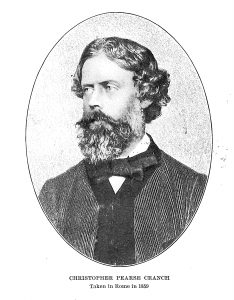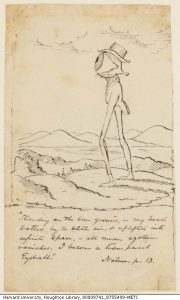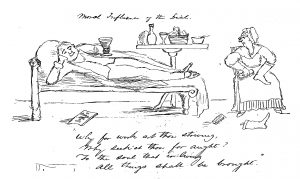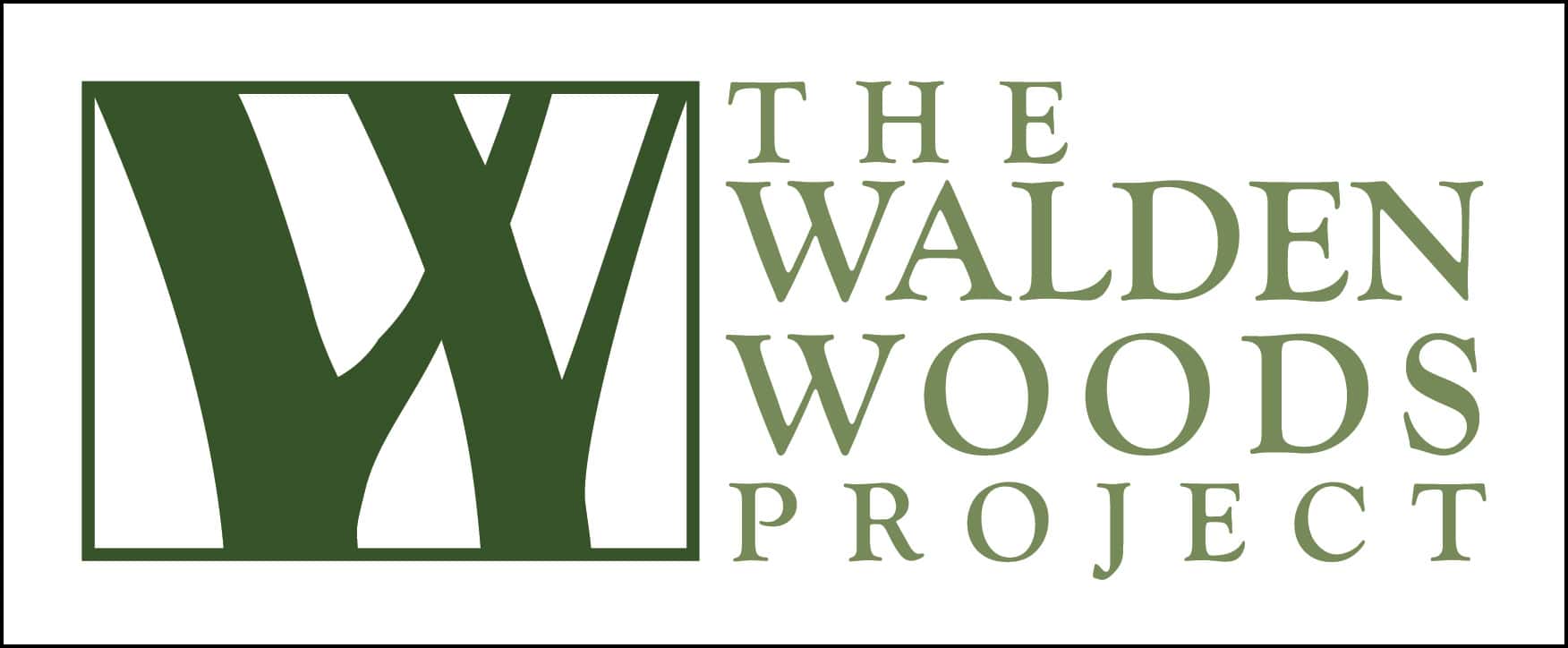Christopher Pearse Cranch
(8 March 1813- 20 January 1890)
Poet, Artist, and Author of Children’s Books

After graduating from Columbian College (now known as George Washington University) in 1832, Cranch entered Harvard Divinity School, where he met Ralph Waldo Emerson (1803-1882), John Sullivan Dwight (1813-1893), and Theodore Parker (1810-1860). In 1836, another Harvard Divinity School alumnus, Frederic Henry Hedge (1805-1890), wrote to Emerson about the formation of a club, referred to as “Hedge’s Club” or “Transcendental Club,” to discuss moral and theological subjects. Club members included Emerson, Hedge, Cranch, Dwight, Parker, Henry David Thoreau (1817-1862) and William Ellery Channing (1810-1884).
Although Cranch is not as well known as his contemporaries, the young Unitarian minister’s poetry and prose was published in The Dial (1840-1844) and his famous rendering of Emerson as “The Transparent Eyeball” (c. 1840) refers to the following passage from Emerson’s Nature (1836):
Standing on the bare ground, my head bathed by the blithe air, and uplifted into infinite space, all mean egotism vanishes. I am become a transparent eyeball — I am nothing; I see all; the currents of the Universal Being circulate through me I am part or particle of God,

Though known more for poetry than art, Cranch’s paintings are likened to the style of the Hudson River School, an art movement that shared some ideas with the Transcendentalists and focused on landscapes of America. Perhaps realizing the ways in which Transcendentalism opposed Unitarian principles, Cranch left the ministry by 1837 and turned to art and poetry. From 1837-1839, the poet edited The Western Messenger (1835-1841), one of thirteen Transcendentalist publications, with fellow Harvard alumnus and Transcendental Club member, James Freeman Clarke (1810-1888). In 1840, Cranch attended a meeting of multiple reformist groups, the “Friends of Christian Union,” which included Amos Bronson Alcott (1799-1888), George Ripley (1802-1880), and Theodore Parker (1810-1860). A few months later, Cranch submitted eight poems and three prose articles for The Dial, Vol. I.

In addition to publishing poetry, 1841 brought changes for Cranch when the poet met Elizabeth De Windt, a niece of John Quincy Adams, in August. The couple married October 10, 1843 and raised four children, one of whom wrote a biography based on personal memories and her father’s unpublished autobiography. As noted by Leonora Cranch Scott, most of her father’s writings went unpublished. Between 1841 and 1890, Cranch and his family moved between Italy, Paris, New York, and Massachusetts. Cranch traveled to Europe to learn landscape painting so he could support his wife and children after leaving the Unitarian ministry. The 1844 Poems is comprised of Cranch’s poetry collection that was previously published in The Western Messenger. Cranch also wrote and illustrated children’s books, including The Last of the Huggermuggers: A Giant Story (1856) and Kobboltozo: A Sequel to the Last of the Huggermuggers (1857). The manuscript for The Legend of Dr. Theophilus; or, The Enchanted Clothes (c. 1870) was undiscovered until the 1980s. According to the editors of the 1993 edition of Three Children’s Novels, which includes the aforementioned stories, the novel length books were written specifically for children and were the first of their kind by an American author.
A prolific poet and author, Cranch contributed to several publications in addition to The Dial. Among the journals and magazines are Dwight’s Journal of Music (1852-1881), a literary and music criticism publication by John Sullivan Dwight; The Nation (1865- current), a publication that began as an Abolitionist journal that continues to publish about current topics; The Atlantic Monthly (1857-current); and The Harbinger (1845-1847), a journal published by the utopian Brook Farm community.
Christopher Pearse Cranch died in Cambridge, MA, on January 20, 1890 and is interred in the city’s Mount Auburn Cemetery.
A Partial List of Published Works
- No. I (Vol. I., no. 1): July 1840:
- No. I (Vol. I., no. 2): October 1840:
- No. III (Vol. I, no. 3): January 1841:
- No. V (Vol. II., no. 1): July 1841:
- No. VI (Vol. II., no 2): October 1841:
- No. VII (Vol. II., no. 3): January 1842:
- No. VIII (Vol. II., no. 4): April 1842:
- No. X (Vol. III., no. 2): October 1842:
The Atlantic Monthly:
- “The Bobolinks” (Sept. 1866)
- “A Friend” (Dec. 1866)
Dwight’s Journal of Music (1852-1881):
- “Sonnet to my Piano” (April 10, 1852)
- “Lines Written at Sea” (April 17, 1852)
- “The Palm Tree of Capri” (May 1, 1852)
- “Midnight Wind” (June 5, 1852)
- “Leopold de Meyer” (June 19, 1852)
- “The Artist” (July 24, 1852)
- “Musings in the Moonlight” (Oct. 30, 1852)
- “A November Sketch” (Dec. 11, 1852)
- “Genius” (Dec. 18, 1852)
- “Odes of Horace” (c. 1852) — letter to brother Edward states one is in first issue of Dwight’s Journal of Music
- “The Painter and His Sitter” (Jan. 19, 1856)
- “A Spring Growl” (April 19, 1873)
- “A Battle of the Elements” (May 16, 1874)
The Western Messenger:
- “The Ant Hills” (July 1837)
- “The Balloon” (Nov. 1837)
- “Duties and Responsibilities of Unitarian Christians (Nov. 1837)
- “Letter on Travelling, &c” (1838)
- “A Ride Over the Mountains” (Aug. 1838)
- “Lightning and the Lantern”
- “The River of Death”
- “The Fountain in the Desert”
- “The Three Mountains”
- “Dreams” (Jan. 1839)
- “Leaves from my Omnibus Book” (July 1839)
Other published works:
- A Poem Delivered in The First Congregational Church in the Town of Quincy, May 25, 1840, The Two Hundredth Anniversary of the Incorporation of the Town. (1840)
- Poems (1844)
- The Last of the Huggermuggers: a Giant Story (1856)
- Kobboltozo: A Sequel to the Last of the Huggermuggers (1857; 1869)
- The Legend of Dr. Theophilus; or, The Enchanted Clothes (c. 1870)
- “Satan: a Libretto” (1874)
- The Bird and the Bell, and other Poems (1875)
- Ariel and Caliban, with other Poems (1887)
- The “Chappel of Ease” and Church of Statesmen. (Sept. 29, 1889)
Translations:
- Virgil’s The Eclogues
- Virgil’s The Georgics
- Virgil’s The Aeneid — in blank verse (1872)
- Horace’s Odes
About Cranch:
- The Life and Letters of Christopher Pearse Cranch (1917) by his daughter Leonora Cranch Scott

